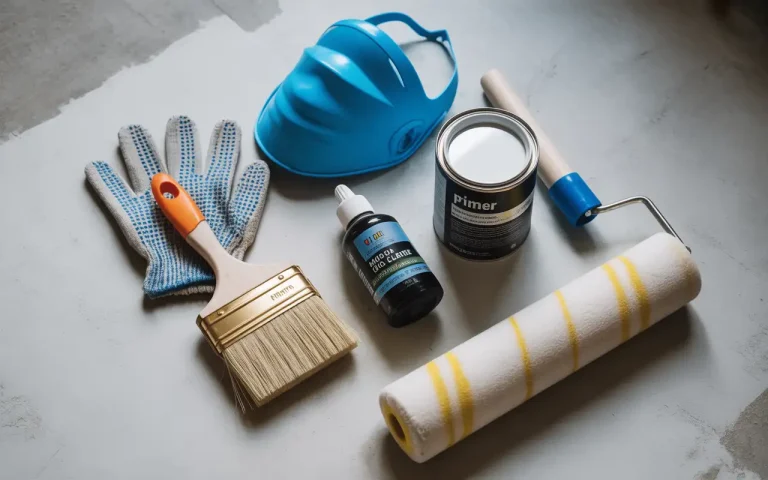Can You Paint Over Mold? Why Experts Say Never
Can you paint over mold? The answer is a definitive no you should never paint directly over mold without proper treatment first. Many homeowners consider painting over mold to save time and money, but this creates serious health risks and property damage. According to recent studies, mold affects 1 in 3 households, making proper treatment essential for your family’s safety and your home’s value.
Does Mold & Mildew Primer Prevent Mold and Mildew?
Mold and mildew primer is a special stain blocking base coat. It helps seal dark spots left after you kill mold and clean the surface. Some products also resist moisture. That helps slow new growth in damp rooms. But here is the key point: these primers do not remove or destroy active colonies. They seal stains after cleanup.
Table of Contents
ToggleCommon myths
- A primer alone kills mold. False.
- You can skip cleaning if the stain is light. False.
- Heavy coats lock it in. Also false.
So should you paint over mold with a primer? Only after the surface is cleaned, treated, and completely dry. At that point, a mold-resistant primer or mildew-resistant paint can help you get longer life from the finish.
When to use what
- Mold-killing treatment: Use first on active growth. Clean with an EPA-registered product, diluted bleach mix, or other approved cleaner that can kill mold spores.
- Mold blocking primer: Use after cleaning and drying to hide stains that might bleed through.
- Mold resistant paint / mould and mildew paint: Finish coat that helps resist future spots in damp areas.
Best practices before primer
- Wear gloves, eye cover, and a respirator rated for mold spores.
- Fix leaks and moisture sources.
- Clean and rinse. Let surfaces get completely dry.
- Test a small spot before full prime.
What Are the Dangers of Painting Over Mold and Mildew?
Skipping cleanup and covering mold with paint sets you up for trouble.
- Health issues: Breathing spores may trigger coughing, sneezing, skin rash, or asthma flare ups. Kids, older adults, and people with weak lungs feel it first.
- Hidden growth: Paint is a film. Moisture and food behind the film let mold grow unseen. Growth spreads into drywall paper, trim, and framing. By the time stains show again, damage is worse.
- Paint failure: You may see peeling, bubbling, or yellow stains pushing through. That wrecks your finish fast and costs more to fix.
- Legal / liability risk: Rentals and home sales can face claims if known mold was painted over. Records of proper cleanup protect you.
Quick Look: Painting Over Mold – Pros vs Cons
Pros: Fast cover up. Looks clean for a short time.
Cons: Health risk, hidden damage, repaint costs, possible legal trouble. Not worth it.
How to Use Mold and Mildew Primer?

Use primer only after you remove growth. Here is a simple step plan you can follow or share with your painter.
Step 1: Clean and Kill Mold
Scrape loose paint. Wash with a mold cleaner. Some use a bleach mix (1 cup bleach to 1 gallon water). Vent the room. Rinse if the product label says to rinse. Goal: kill mold and remove debris.
Step 2: Let the Area Dry Completely
Air flow matters. Use fans, dehumidifiers, or open windows when weather allows. Surfaces must be completely dry before any coating. Trapped damp spots lead to failure.
Step 3: Apply a Mold-Resistant Primer
Stir well. Brush or roll a thin, even coat. Follow label dry times. Spot prime stained areas first, then full coat. This is your mold paint prep stage.
Step 4: Paint With a Mold-Resistant Topcoat
Finish with high quality mold resistant paint or paint for moldy walls made for baths, kitchens, or basements. Many brands market “bath and kitchen” moisture formulas. These help but still need good air flow.
Tools & Safety Gear
- N95 or respirator (better in large jobs)
- Gloves
- Eye shield
- Scraper and stiff brush
- Cleaner rated for mold
- Fans or dehumidifier
- Roller, tray, angled brush
Tips for Keeping Mold Away After Painting
Stopping moisture is the real fix. Use this checklist after your paint job.
Moisture Control Checklist
- Keep indoor humidity below 50 percent.
- Run bath fans 20 minutes after showers.
- Vent cooking steam outdoors.
- Fix roof and plumbing leaks fast.
- Seal window gaps and exterior cracks.
- Clean bath tile and trim often.
- Use a dehumidifier in basements.
- Store firewood and wet gear outside living areas.
Add mold resistant finishes in high risk rooms: baths, kitchens, laundry, and below grade spaces. In very damp spots, pick coatings sold as mould and mildew paint or add anti-microbial additives (follow label rules).
San Diego Custom Painting: A Solution for All Your Painting Problems and Needs
If you live in San Diego County, you do not have to face mold stains alone. San Diego Custom Painting helps homeowners and property managers handle prep, primer, and finish the right way. We inspect surfaces, flag moisture issues, and use proven products that stand up in coastal air.
Need pro help fast? Tap into our local exterior painting and interior painting services in Spring Valley. Our team knows how local weather, marine air, and older stucco homes affect paint jobs. We guide you on when painting over mold is safe (after removal) and when deeper repairs are needed.
Explore our services:
FAQ'S
How do you treat mold before painting?
Scrub with a cleaner that kills mold. Rinse if needed. Dry the area fully. Prime with a mold-resistant primer before finishing paint.
What happens if you paint over mold?
What happens if you paint over mold is simple: it grows back under the coat, may stain, and can hurt air quality.
What kind of paint can you put over mold?
After cleanup, use a mold resistant paint or bath and kitchen coating. Pick one marked for high moisture.
Can you paint Kilz over mold?
Kilz can hide stains but it does not kill growth. Clean and dry first. Then prime and paint.
